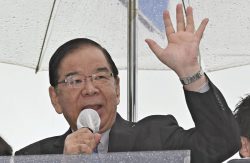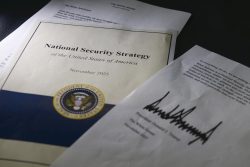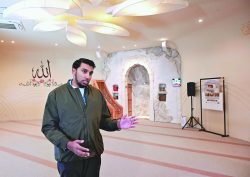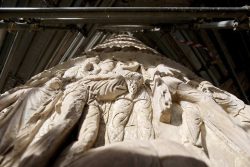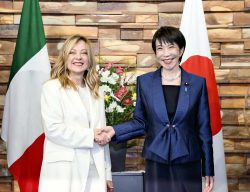Sado Gold Mine Recommendation: Offer Thorough Explanations to Win World Heritage Inscription
15:58 JST, June 12, 2024
Although the cultural value of the Sado gold mine complex has been recognized, homework has also been assigned. It is hoped that the government will make thorough assertions and explanations for the site’s registration in the World Heritage list and broaden the understanding of other countries.
The International Council on Monuments and Sites (ICOMOS), an advisory body to UNESCO, has given the “Sado complex of heritage mines” on Sado Island in Niigata Prefecture a referral recommendation, the second-highest rating after “inscription.”
While acknowledging that the gold mine complex is worthy of consideration for inscription in the World Heritage list, ICOMOS made certain requests, including a review of the areas to be designated as a World Heritage site.
In the 16th to 19th centuries, the gold mine complex on Sado Island was among the world’s most productive as it developed and maintained techniques to produce high-purity gold as a traditional handicraft industry, even while mechanization was advancing at mines elsewhere around the world.
All six cultural heritage sites that received referral recommendations last year have since been registered as World Heritage sites. While local residents had hoped for an inscription recommendation, it can be said that the first hurdle has been crossed in preparation for the UNESCO World Heritage Committee meeting in July, when the final decision on inscription will be made.
Japan’s Council for Cultural Affairs selected the gold mine complex on Sado Island as a candidate for domestic nomination in 2021. However, South Korea protested the nomination, claiming that the site was a place where people from the Korean Peninsula were forced to work during wartime.
This time, as an additional recommendation, ICOMOS requested that Japan provide historical explanations and exhibits at the site for all periods when gold was mined. This is perceived as a request to take into consideration the opposition from South Korea.
Both Japan and South Korea are members of the 21-member World Heritage Committee. Resolutions essentially must be unanimous to pass. South Korea has insisted that historical facts about workers from the Korean Peninsula be taken into account. Seoul has put pressure on Japan, asserting that it will decide whether to assent to the listing depending on how Japan addresses the issue.
On the other hand, Chief Cabinet Secretary Yoshimasa Hayashi said, “The government as a whole will deal with the matter.” He added, “We are holding discussions with South Korea in a sincere manner.”
It is hoped that the Japanese government will do its utmost to coordinate with South Korea toward the inscription of the gold mine complex as a World Heritage site. It is important to thoroughly explain the history and cultural significance of the gold mine complex and keep a stance of maintaining the things that Japan should assert.
Previously, when it was decided to add sites related to Japan’s Meiji era (1868-1912) industrial revolution to the World Heritage list in 2015, South Korea claimed that there was forced labor there. Japan countered that it could not be called forced labor, leading to a heated exchange of arguments.
Since the inauguration of South Korean President Yoon Suk Yeol, Japan-Korea relations have been on the road to improvement. It is hoped that both countries will engage in dialogue based on mutual respect so as not to create a new cause of conflict.
A situation must be avoided in which historical legacies are ignored due to political conflicts.
(From The Yomiuri Shimbun, June 12, 2024)
"Editorial & Columns" POPULAR ARTICLE
-

Artificial Intelligence Expands Possibilities for Foreign Language Learners
-

Build Intellectual, Physical Strength, As Well As Communicative Power / Japan Should Move from Beneficiary to Shaper of World Order
-

Global Economy in Turmoil: Prevent Free Trade System from Going Adrift / Risks to Financial Markets Must Be Heeded
-

Japan-China Strain Set to Persist as Beijing Officials Self-Interestedly Bash Tokyo; Takaichi Unlikely to Back Down
-

Elderly People Living Alone: What Should be Done to Ensure Living with Peace of Mind until the End?
JN ACCESS RANKING
-

Japan Govt Adopts Measures to Curb Mega Solar Power Plant Projects Amid Environmental Concerns
-

Core Inflation in Tokyo Slows in December but Stays above BOJ Target
-

Major Japan Firms’ Average Winter Bonus Tops ¥1 Mil.
-

Bank of Japan Considered U.S. Tariffs, Coming Shunto Wage Hike Talks in Its Decision to Raise Interest Rates
-

Tokyo Zoo Wolf Believed to Have Used Vegetation Growing on Wall to Climb, Escape; Animal Living Happily after Recapture




